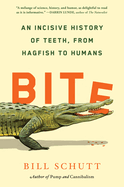
For readers who have ever been curious about the phrase "long in the tooth" or wondered just how vampire bats actually eat, Bite by Bill Schutt (Pump; Cannibalism) is a treasure trove of tooth-related facts and trivia. Broken into nibble-size chapters that can be read in short sittings, Bite is a terrific airplane or beach read for the nonfiction set.
Schutt traces teeth back to their very beginning and follows them through millions of years of evolution, explaining how they helped humans develop as a species. Not just tools, teeth have also been an indicator of social status. Readers will learn about Etruscan teeth jewelry, antique dentures, and tooth worms.
Schutt covers the animal kingdom in depth, discussing tusks, fangs, baleen, and more. For instance, baleen is not actually made of bone but of keratin, the same protein that helps form human hair and fingernails. One chapter considers frogs (some have teeth, others do not), and Schutt also devotes chapters to shrews, some species of which can die of starvation in as little as four hours, have iron in their enamel, and are, in fact, venomous; and to candirus, the South American fish that could purportedly jump out of the water and into the human urethra ("pretty much an impossibility," Schutt writes, citing the work of a biomechanics expert).
Fascinating and intensely niche, Bite is excellent popular science perfect for readers who've enjoyed Schutt's previous work and fans of authors such as Mary Roach. Bite is fun, accessible, and informative. --Alyssa Parssinen, freelance reviewer and former bookseller

